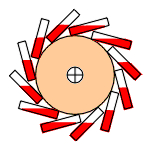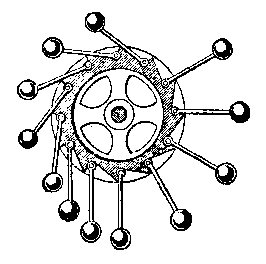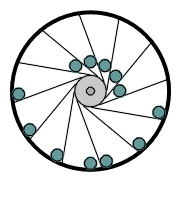The Hall of Machinery
| Warning! In this exhibit hall many fundamental laws of physics are suspended and many others are violated. Stay on the safety walkways and do not attempt to touch the exhibit cases.The museum cannot be responsible for any injuries to visitors due to unexpected consequences resulting from suspension of the laws of nature.
Watching these machines spin continually can induce a sense of vertigo. If you feel dizzy, grasp the safety handrail and close your eyes until the feeling subsides. |
![]()
Hans-Peter Gramatke has generously designed and drawn animated GIF files and donated them to our museum. They carry the label [HP] and he retains copyright to them. These form the heart of the collection displayed in this hall. Visit Hans-Peter's web site in German or English.
Overbalanced Wheels
[Click on each [ANIMATE] to see the machine in motion.]
 |
The Bhaskara wheel, c. 1100. This wheel had containers of mercury around the rim, strategically positioned in the vain hope that the wheel would always be heavier on one side of the axle. This design reappeared in many countries, including in Europe. [ANIMATE] [©HP] |
 |
A variation of Villard de Honnecort's wheel, using weights on hinged arms. [ANIMATE] [©HP] |
 |
An 18th century variation of the overbalanced wheel. [ANIMATE] |

|
The "Arabian" wheel with articulated arms. The design goes back to India as early as the 8th century. [©HP] [ANIMATE] |
 |
People surely noticed that the Arabian wheel just wouldn't maintain motion. British mechanist George Linton improved the design by transferring balls along a ramp from one side to the other without being carried over the top. Clever! This uses the new (but futile) principle of incorporating unattached shifting weights into the design. (Some books incorrectly spell the inventor's name "Lipton", but his 1821 British Patent No. 4632 confirms that it is "Linton".) Tom Monti, who contributed the animation, says "My working model failed to supply enough power for my laptop and the camera, so I had to resort to a crude illustration. The only difficulty was timing the balls, so they didn't roll off the drawing, and onto the keyboard. I hope it continues to operate on your display." [©Tom Monti] [ANIMATE] |
 |
The 18th century Scottish astronomer James Ferguson designed this machine with ball weights on hinged arms connected to heavy weights sliding in frames. Frictionless pistons, of course. As the weights fall in their frames they pull the hinged weights to a larger radii. This introduces the new (but ineffective) principle of cross-axle mechanical linkage. Though Ferguson had interest in such devices, he knew they couldn't work. He concludes his discussion of this one saying "...it might be supposed that this machine would turn round perpetually. I have shown it to many who have declared it would; and yet for all that, whoever makes it, will find it to be only a mere balance. I leave them to find out the reason." [ANIMATE] [©HP] |
 |
Edward Somerset, the Marquis of Worcester (1601-1667) included this in his 1655 book A Century of Inventions. Jacob Leupold (1700-1799) analyzed it and showed why it wouldn't work. [Note that HP shows the balls bouncing when they strike a wall. The collisions must be perfectly elastic, otherwise mechanical energy would be converted to thermal energy.] [ANIMATE] [©HP] |
 |
After more than eight centuries of fruitless inventions, here's a perpetual motion idea for the 21st century. Invented by Donald Simanek and Hans-Peter Gramatke in Nov. 2005, it has classic simplicity. It employs the time-honored principles of overbalance, positive feedback, and reactionless forces. A continuous coiled spring under some tension is supported by two gears connected by a restraining chain drive or timing-belt, the whole thing arranged so that there is continually twice as much weight of spring on the right side. This gives it a 2:1 weight ratio, or 200%, which is certainly over unity, promising there's enough output to overcome friction and still provide enough extra to heat your morning cup of coffee. Read more about it. [ANIMATE] [©HP] |
 |
Modeling programs and animated grapics are being widely used in education. To remind us that animated graphics do not necessarily represent reality, Karl E. Leitzel (Graphic Designer, Penn State World Campus) created this little impossible device. |
Return to the main gallery